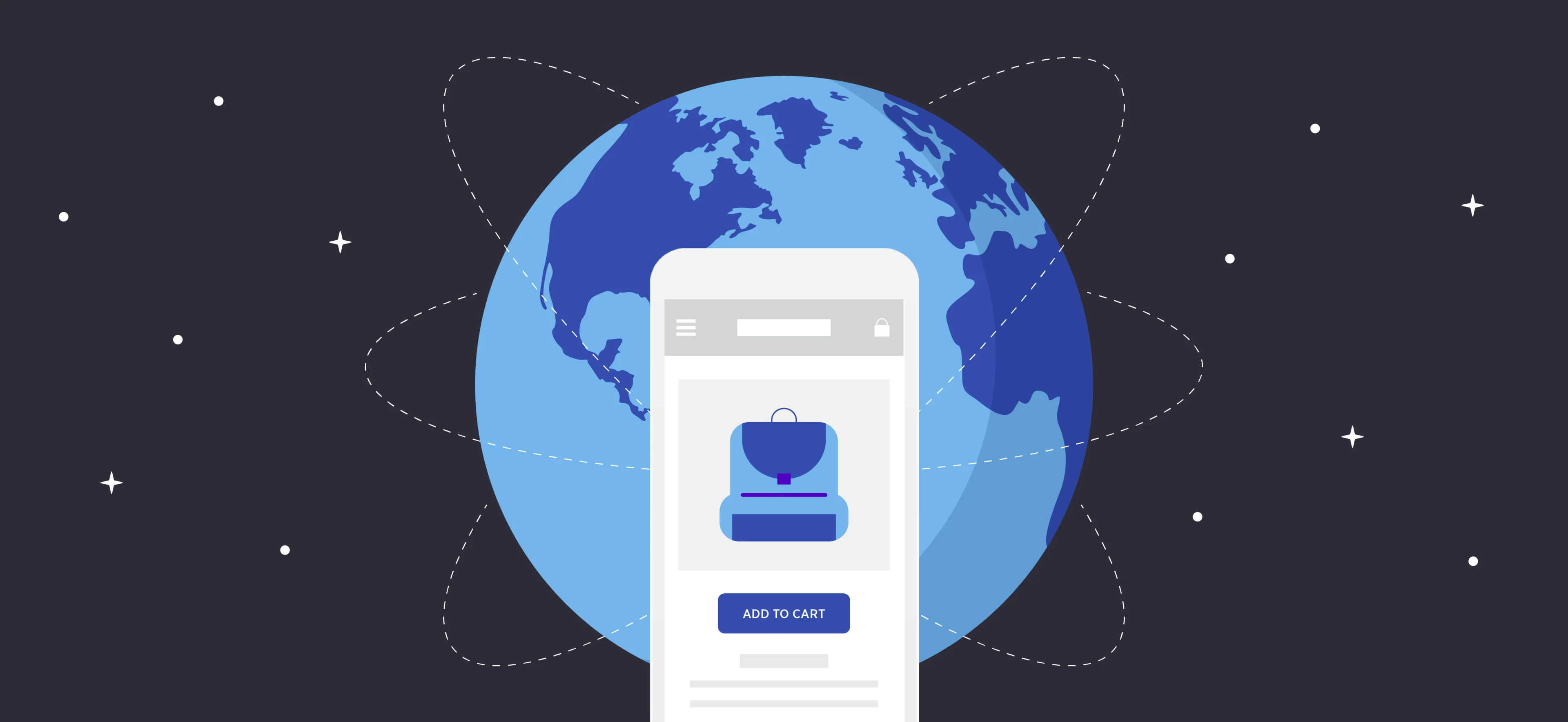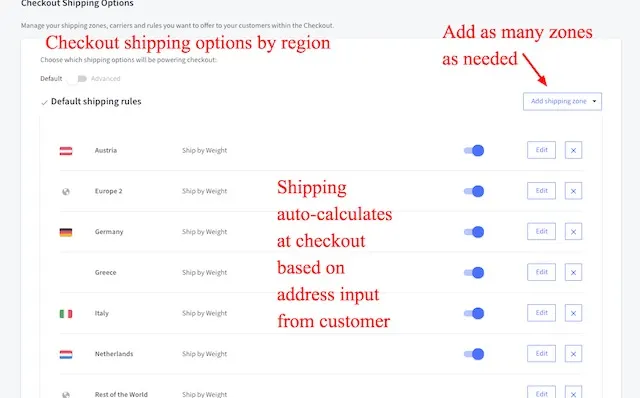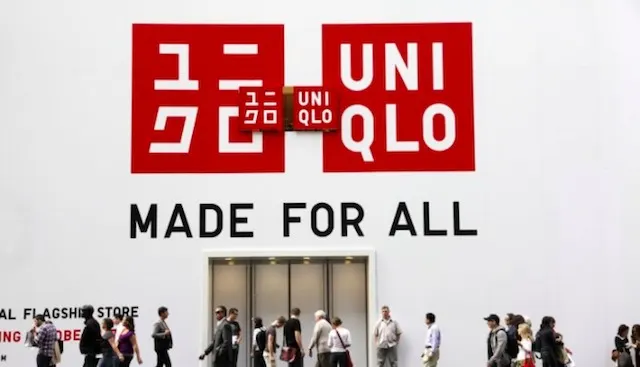International Ecommerce Strategy: How to Market, Scale and Win at Every Stage

When it comes to ecommerce and doing business globally, Brian Beck, current SVP of ecommerce and omnichannel strategy at Guidance Solution, knows a thing or two.
He manages the digital channels of some of the world’s leading retail brands, including, but not limited to:
Eastbay
Foot Locker
Kate Somerville
Ray Ban
Toms
While selling across borders can be complicated, Beck employs practicality as a tool for creating a successful cross-border go-to-market strategy, in what he calls a “don’t boil the water” approach to doing business.
That essentially means not to go too fast. It is overwhelming to begin selling abroad. You must figure out:
Where to sell
How to sell
How to actually get your product in country
All of those questions can cause more anxiety than optimism. To combat that fear, Beck uses –– and you should too –– the crawl, walk, run approach.
This methodology allows merchants to:
Properly assess opportunity
Define strategy
Validate investments
Deploy a global solution at scale and optimal speed
To implement, consider the following phases:
Crawl – Simple solutions with simple tests
Walk – Act global, think local
Run – Optimize delivery and in-market experience
This post will guide you through the process of getting started, ending with a blueprint for what to do, when, why and how to make it scalable. After that, we’ll dive into specific steps for your company stage.
After all, going international isn’t just for the big guys. Let’s dive in.
The International Expansion Playbook
What if you are ready to invest in international expansion and localization to own a brand new market long before you competitors?
That’s what this guide will teach you to do.
Crawl: Test and Learn with Minimal Risk
In the “crawl” phase of this process, the goal is to implement simple solutions with simple tests. This allows you to quickly test and learn without exposing your business to too much risk.
As you begin to test, start with the following:
Enable international shipping, slowly – Test international shipping with carriers such as DHL, FEDEX, or UPS, and do it in markets that are more open to cross-border commerce. Australia and Canada are great starts.
Get familiar with duties & tariffs – Shipping globally comes with an added cost. Learning how those costs impact the customer experience early allows you to figure out how you want to calculate Total Landed Cost. Be transparent and inform international shoppers at the time of checkout that they may have to pay additional duties and tariffs once the product lands in-country if you do not collect them at the time of checkout.
As a part of this phase, don’t boil the water.
Refrain from being overzealous in selecting markets to test cross-border commerce.
Do one or two at a time, and do them right!
For many online brands, simply looking through your analytics to see where your highest number of international purchases have come from can land you in the “walk” phase, which is outlined below.
Walk: Shift Priorities from Acquire to Keep
You enter the “walk” phase as your brand establishes a global footprint and builds confidence in a specific market. The “walk” phase focuses on in-market optimization.
As you begin to see success in cross-border commerce, focus on offering a more seamless experience to continue earning increased sales, trust and market share.
Better understanding consumers is the goal –– ultimately leading you down a path of localization, which creates a better experience for international shoppers.
To be successful, create a truly localized shopping experience by:
Localizing your website – Focus on localizing your content, currency and language. Remember, content means your photos, text, ads, etc.
Considering your merchandising strategy – Keep in mind climate and holidays when merchandising.
Offer first-world experiences relevant to your region: Does your new region use Amazon? Offer Amazon Pay as a one-click payment solution to increase conversion and trust. Have you A/B tested a one-page checkout in your new market? Those increase conversions in the U.S. –– could they elsewhere? Test it out! Offer the same new, more convenient experiences you offer to your domestic base to your international base, even if it’s just a test to see if it works.
As the strategy begins to work and your sales increase, focus then on investing in people, process and technology. This is important because as your sales scale, your infrastructure should as well in order to protect your global investment.
Run: Optimize the In-Country Experience
“Fully committed” is the best descriptor for the “run” stage –– the final stage.
In this stage, brands are forced to take a hard look at optimizing the in-country customer experience, focusing on the following areas:
Local distribution – Focus on shortening the time of delivery and overall cost of logistics. One way to do this is to open a local warehouse to decrease shipping costs and times for the customer.
Blending digital and physical – In emerging markets like China, online-to-offline (O2O) is changing the way people buy online, through incentives like pick-up or try on in-store. Though there have been varieties of this in the U.S., many of which haven’t taken off, in regions like China, this is huge. It also removes additional shipping costs for both you and the consumer.
Automating workflows – Focus on transitioning analog processes into automated wins, allowing your team to focus on creating immersive experiences rather than just tasks.
Create a Basic Blueprint for Success
Taking the “crawl, walk, run” approach to cross-border commerce allows you to test out a new market, prove there is product interest, and then double down to win.
And, once you do it right and win, you have a blueprint for success in the future –– where you can replicate a go-to-market process for success in new markets.
Now that you know the basics for launching a cross-border selling channel, let’s look at how businesses of your specific size (small, mid and large) can attack an international strategy at scale.
4 Steps for SMBs to Sell Globally
For SMBs, selling across borders is exciting and risky, all at the same time.
Depending on what you sell, your margin for error may be narrow.
Limiting your exposure to mistakes is and should always be at the forefront of any decision.
Additionally, figure out how to be nimble by leveraging technology as a catalyst for engaging in cross-border commerce. Just because you are small does not mean that you are restricted in going global. It just means that you must think smarter and harder as to how you do it.
As you begin to romanticize the idea of selling across borders, keep in mind the following:
Avoid technology investments – For many SMBs, there is really no need to invest in channel management software or big integrations. Be scrappy and shrewd. Most of your early decisions when selling across borders will be just testing and learning, so keep the costs down. A ecommerce platform like BigCommerce should be all you need to do the trick.
Scale smart – Don’t try to do it all yourself! As you scale globally you must account for entirely new sets of customer service and operational overhead that you will need to fulfill. Look for young talent that can wear multiple hats and understand emerging channels like social commerce.
Travel the path of least resistance – We get it, you want to sell everywhere, on every marketplace and on every social media channel. That’s fine, just make sure that you connect in ways that help you, not hurt you.
Here are the top 4 ways to grow your global presence for SMBs.
1. Gauge Interest by Offering International Shipping
The first step in going global is to offer international shipping. The easiest way to do it is by creating business accounts with major carriers such as:
DHL
FEDEX
UPS
USPS
You can then automatically connect your BigCommerce store to offer customers (including international customers) real-time quotes at checkout.

Be realistic when setting shipping expectations with international shoppers by being very clear in communicating total landed cost and who is responsible for duties and tariffs.
Additionally, it is always good to have a dedicated section on your website to clearly define each point. Below is a perfect example of communicating delivery speed, establishing who is responsible for duties and tariffs, and potential delays due to customs:
International Orders will be processed and shipped within 48 hours of purchase, a minimum delivery time of 15 business days (excluding U.S. holidays) should be taken into consideration as International borders and Customs could delay estimated delivery time. International Orders may be subject to import taxes, customs duties and fees levied by your country’s customs department upon arrival.
When ordering, the recipient of the shipment is the importer of record and is responsible for any of these import fees, as well as complying with all laws and regulations of the destination country. We do not collect duties and taxes, and as smart as we are, we cannot predict what your charges may be. Customs policies vary widely from country to country, so please contact your local customs office for more information.
Providing shoppers this type of honesty before ordering significantly reduces the chances of having a return or a customer unwilling to pay duties and tariffs once their product arrives.
In the end, offering international checkout allows merchants to sell across borders via a domestic distribution center and tap into the potential of foreign markets.
It is important for SMBs to understand that while you may not be able to match expected delivery speed, you can still build enough confidence with international customers by setting realistic expectations that your brand can meet.
2. Double Down on Social

For SMBs, social media is the most effective way of going global, fast!
With Facebook, Instagram, Pinterest, Twitter and WeChat all offering in-app shopping, it makes the most sense to use each platform as channels to engage and acquire international customers.
Moreover, each platform now provides merchants the ability to create customer audiences for advertising.
This means you can geo-locate and target specific markets with localized messages, enticing shoppers to click-thru to your website.
Here are 5 ways to make this work:
Localize Advertising: When leveraging social media advertising platforms, be sure to localize your content. Merchants have the tools to identify specific audiences but they also need localize their message to maximize their reach and engagement.
Pixels, Pixels, Pixels: There is nothing worse for a SMB than not being able to calculate ROI. Before you launch your social media advertising campaigns, be sure to have your pixel installed with conversion tracking. This allows merchants to be able to calculate ROI for a specific advertising campaign by associating conversions directly with it. This will give you a better understanding of which channels are working for you for individual markets, and let you know where you need to double down.
Leverage Social to Build an In-Market Footprint: In countries like China, selling on local marketplaces may be unrealistic for SMBs. However, social platforms like WeChat and Weibo provide smaller merchants the opportunity to easily connect their product with new consumers. Test those out first.
Sell on Facebook: Facebook now allows merchants to sell products directly on the platform, providing shoppers the ability to securely checkout. This gives your brand a potential new channel to acquire, engage and retain shoppers. Additionally, Facebook remains the most globally used social media channel and provides, via Facebook Messenger, a quick and easy way to communicate with shoppers.
Test out WeChat: For SMBs, selling across border into China represents massive opportunity. Moreover, in the last year, Tencent, WeChat’s management group, has begun to allow non-Chinese merchants to sell into China via the social network application. Now non-Chinese merchants can apply, which takes 2-4 months and costs roughly $1,300 (USD), and if accepted, open Official Storefronts.
3. Marketplaces Within Means
Being an SMB does not restrict which marketplaces you launch in. It just means you should be diligent and conservative when selecting one.
As you identify which marketplaces outside of North America may be of interest, start with those you are familiar with.
For example, Amazon has global properties in China, France, Germany, Japan, India, Italy, Mexico, Spain, Canada, the United Kingdom and recently Australia. Entering markets on a marketplace that you are already familiar with expedites entry and allows you to focus on creating awareness in-country.
4. Alternative Means of Discovery: Google Shopping
If you have not already, sign up for a Google Merchant Account and sync it to your AdWords account. You can easily send product data via a data feed through an app on your ecommerce platform to make your products accessible via Google Search.
Additionally, you can create targeted AdWords campaigns for specific markets or restrict them using geo-location.
The International Expansion Playbook
What if you are ready to invest in international expansion and localization to own a brand new market long before your competitors?
That’s what this guide will teach you to do.
5 Steps to Selling Globally for Mid-Market Merchants
For mid-market merchants, the global landscape is highly competitive. Depending on your product and vertical, you may be entering a saturated market.
As you begin to move beyond the bounds of just shipping internationally, it is imperative that your strategies and tactics be experience driven, with the in-market consumer always in mind.
By now, for instance, you should be establishing fully localized ecommerce capabilities.
As you move from “just getting product there” to creating immersive in-country shopping experiences, keep in mind that models such as O2O (online-to-offline) are changing the way consumers shop in emerging markets like China.
By understanding in-country commerce models, you will be able to better define in-country shopping experiences and fully integrate your brand into the everyday life of your cross-border consumer.
The Big O in Emerging Markets: O2O Commerce
First things first: what is O2O?
Traditional ecommerce models are categorized as B2B, B2C and C2C, defined by parties involved in the transaction.
With digital now infiltrating offline businesses, studies have explored a new set of categories that differentiate business models not only by “who is involved in the transaction” but “how business is done”– meaning the transaction behavior and process.
By doing so, a new business model — online to offline (O2O) –– is becoming a growing segment, in addition to traditional online or offline only models.
eMarketer defines the segment like this:
In markets like the U.S. and the UK, O2O is generally considered shorthand for click-and-collect commerce — items purchased online and picked up in-store.
In China, the O2O label also applies not only to travel, transportation and other services, but often to services that may be arranged for online, then paid for at the point of service.
In fact, click-and-collect purchases of physical goods are generally less common in China, largely because auto ownership is not as widespread and many prefer the convenience of having goods delivered to their home.
Indeed, in China alone, O2O sales increased 38% in 2015 to RMB 335 billion ($53.78 billion), and are projected to reach RMB 428 billion ($68.71 billion) this year.
Growth is expected to remain over 20% YoY until 2018, when O2O will account for RMB 626 billion ($100.501 trillion) in annual sales.
Optimize for In-Country Customer Experience
Consumers everywhere want online shopping to be seamless. This starts with UX –– and catering to country-specific expectations.
Key requirements should include:
Consistent and templated site architecture
Flexible front and backend integration capabilities
Multi-store, multi-currency
Scalable server architecture
Having this foundation will allow merchants to move quickly into new markets and not be bottlenecked by laggard technologies –– inherently allowing them to be able to easily deploy 3rd party payment, shipping and customer service software integrations as needed.
Let’s explore each a bit more.
The power of templates: Templated digital architecture is a catalyst for business efficiencies when selling across border. This allows merchants to invest in localization rather than web development, enabling them to personalize and create tailored online shopping experiences at-will –– and at scale. Things to remember here:
Be mobile optimized – This is not just HTML and CSS either, when considering product photography, start with smaller screens first, as mobile dominates almost 70-85% of web traffic in emerging markets.
Start with Finnish or German – Have your design team build templates with a Finnish or German locale language. You will be surprise how you will later run into layout issues when starting in English.
Build a plug-and-play mentality: The reality of cross-border commerce is that it is a continuous test and learn process. Make sure as you develop your website that you promote a plug-and-play approach with your development team. This will allow you to be able to quickly add or get rid of solutions that enable or prevent you from selling in specific markets downstream.
Locale, locale, locale: As merchants scale globally and sell, managing data (customers, orders, and products) gets tricky. Make sure that you have or select an ecommerce platform that provides multi-store capabilities –– not just something that recommends you use a single site for your international selling.
Scalable server architecture: As mid-sized merchants begin spinning up local sites, some countries mandate that you have in-country server solutions. For example, in Russia merchants must abide by the following requirements:
Personal data may be collected, stored and used only with the consent of the data subject (the person to whom the data refers), preferably in written form.
Since September 2015, personal data should be processed by means of information databases that are physically located on Russian territory.
Data operators storing personal data are liable for keeping such data confidential and are not permitted to transfer, share or disclose such data without the consent of the data subject, with special attention paid to internal control mechanisms.
Full protection of personal data should be provided through a range of organizational and technical measures defined by the law.
The operator should draft and make publicly available an internal policy for processing personal data.
These rules apply specifically to personal data – which should not be confused with any user-related data. According to Russian law, the primary characteristic of “personal data” is the ability to identify among many persons a specific, unique individual.
Another example of potential server constraints is in China. While the government does not impose in-country servers, if you do expect to conduct a large amount of business, hosting a server in China should be the first choice.
To do so, you will need to get an ICP license, which are available only to Chinese citizens or registered businesses. With that said, an in-country partner would be needed.
3 Steps to Selling Globally for Enterprise Brands
For large merchants, cross-border commerce becomes a game of efficiency and profitability. Ask yourself these two questions consistently:
“How can we get our product there faster?”
“How can we cut our costs doing it?”
Beyond this, large brands are also faced with the fact that tourism plays a major role in how international shoppers first engage their brand.
For these merchants, cross border commerce is more about evaluating and working within your current business models.
This is most notable for retail brands, as in many cases you have already established a brick-and-mortar location in major emerging markets like China, Japan and the United Arab Emirates.
If you fall within this category, know that creating synergy between digital and physical properties and optimizing for delivery is where the leaders separate themselves from the laggards.
1. In-store Global, Online Local
For large retailers, tourism is a catalyst for international shoppers to discover your products. According to Pitney Bowes, over 75% of international shoppers engage in the practice of “in-store global, online local” and it is growing annually.
So, what exactly is “in-store global, online local”?
“In-store global, online local” is when consumers make in-store purchases during their international travels, and follow up with online purchases from that same cross-border retailer in their home country.
Most cross-border shoppers in China, India and South Korea cited that they often or always revisit a retailer online following international travels.
This gives brands the opportunity to connect with international shoppers in a way that provides them the ability to “touch and feel” products, significantly reducing the risk of potential returns and dissatisfaction –– while providing the brands a favorable bridge into foreign markets.
The real question is, “What do merchants do next, once that consumer returns home to their native country?”
2. Balancing Localization and Brand Experience in Emerging Markets
As we previously pointed out “in-store global, online local” gives retailers an entry point into foreign markets.
So how do merchants maintain their brand experience without diluting it with localization?
Finding the right blend of brand experience versus localization is certainly tough, but relying on core brand principles to be drivers of experiential strategies in-market works. Let’s look at how Nike and Uniqlo have made this work.
Just Do It; How Nike is Running in Foreign Markets
Nike leverages digital and physical properties across 44 global locations to communicate its brand message via in-country “Come run with us” programs that turn the brand into a lifestyle beyond a retailer.
Nike does this by blending expert guidance from professional “pacers” and “coaches” as well as by offering digital training apps that creates a connection, experience and loyalty for in-market consumers.

Uniqlo: Using Physical as a Platform for Local Communities
In 2016, this Japanese merchant made significant strides to embed themselves into the communities surrounding their 840 worldwide physical locations.
To effectively do so, Uniqlo shifted away from the single-minded strategies of standardization long favored at large global retailers, which traditionally focused on fine-tuning their store formats, merchandise mix, marketing and other elements of their formulas.
Today, Uniqlo dedicates floor space to local entrepreneurs to express their global ideas, but in a local way.

3. Optimizing Trade Routes
As large merchants scale, distribution becomes a vital part of success.
As many large merchants have physical locations in-market, it is important to create an ecosystem of regional and in-country shipping methods.
For example, in Asia Pacific, you may split shipping methods regionally based on where you have physical locations versus leveraging a provider in a country you do not. To effectively optimize trade routes, keep the following in mind:
Leverage physical stores as your first method of delivery: The easiest way to ship products globally is by doing it from locations that already have the items in-stock. By leveraging local physical stores as a distribution center, merchants can provide same-day shipping in select markets.
Set up localized shipping methods for regions in which you do not have physical locations: If you do not have physical locations, evaluate regional shipping partners that can provide you access to localized shipping methods. When evaluating, think beyond just the shipment and look at their resources. Work to kill two birds with one stone by getting a blended rate that includes customer service and warehousing.
For emerging markets, leverage final mile providers that have a wider global reach: For emerging markets outside of the traditional hotspots like China, India and the United Arab Emirates, find a partner that has a robust final mile matrix. What does this mean? You want to partner with a final mile provider that has gone there before. Shipping into countries in Latin America, Southeast Asia and North Africa can be tricky, so having a partner that understands these local markets will reduce abandonment and increase delivery success.
Featured Final Mile Provider
wnDirect enables retailers to realize their international potential by providing managed delivery solutions which overcome the challenges of global expansion.
By redefining international ecommerce delivery, they enable retailers to go global with a range of dynamic solutions that have been tailored specifically for ecommerce.
Final Word
Whether you “crawl,” “walk,” or “run,” it is important that you be realistic in launching internationally. Cross-border ecommerce must be done strategically and carefully, no matter the size of your business.
The International Expansion Playbook
What if you are ready to invest in international expansion and localization to own a brand new market long before your competitors?
That’s what this guide will teach you to do.

Sergio Villasenor is the Founder and CEO of Elliot, a software that simplifies global commerce. In the last decade, he’s guided some of the world's leading retail brands in powering their omnichannel strategies. He pioneered an agile, omnipresent approach and methodology that provides brands solutions with measurable business impact. Some of those brands include: Anastasia Beverly Hills, Buscemi, J Brand Jeans, John Varvatos, Juicy Couture, Rag & Bone, the Frye Company and more than 30 others.


